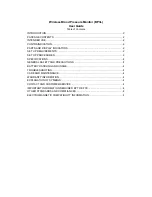
47
Kaleido-X16
Hardware Description & Installation Manual
From client to multiviewer
The following ports must be open on the Client (i.e., the workstation running XEdit):
From multiviewer to client
From multiviewer to multiviewer
The following ports, used for inter-frame communications, are open by default on all
Kaleido Software systems:
Port
Used for
Transport Notes
443
HTTPS
TCP
Used by XAdmin for secure access
7
HTTP
TCP
Used by XEdit for ping probing
80
TCP
Used by XEdit and XAdmin
5122
TCP
Used by XEdit for
keepalive
(heartbeat)
5432
TCP
Used by XEdit for export operations
7600
TCP
Used for troubleshooting the REST API (remote control)
13000
TCP
Online connection
13100
TCP
Used for calibration data from XEdit
5120
RCP2
TCP
Used to listen for Kaleido Software discovery packets
10000
TCP
For RCP2 protocol
10001
TCP
For RCP2 protocol
5120
UDP
On multicast 230.8.8.9 for RCP2 protocol
5121
UDP
For RCP2 protocol
Port
Used for
Transport Notes
1024–5000
1
49152-65535
2
1.For Windows XP and earlier
2.For Windows 7 and later
Java RMI
TCP
Remote Method Invocation (client/server
communication). Dynamic Allocation of ports.
Required for communication between client and
Application Server.
Port
Used for
Transport Notes
22
SSH
TCP
Secure Shell Login is required to login to a multiviewer for
maintenance.
4160
Java Jini
TCP
Responsible for discovery and communications between
devices/services on a network.
8080
HTTP
TCP
8082
TCP
Internal communication
8083
TCP
Internal communication
8084
TCP
Internal communication
Summary of Contents for Grass Valley KALEIDO-X16
Page 20: ...20 Overview Functional block diagrams...
Page 26: ...26 Installation CompactFlash...
Page 42: ...42 Multiviewer Cabling Enabling EDID Auto Detection from the Monitor Wall...
Page 126: ...126 Configuring a Kaleido X16 Cascade Limitations...
Page 151: ...151 Kaleido X16 Hardware Description Installation Manual...
















































